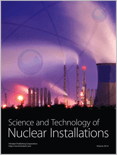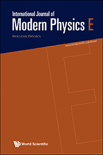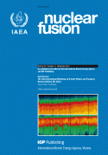
Science and Technology of Nuclear Installations
Scope & Guideline
Fostering Collaboration in the Nuclear Science Community
Introduction
Aims and Scopes
- Nuclear Reactor Design and Safety:
The journal emphasizes research on the design, operation, and safety assessment of nuclear reactors, including advanced reactor concepts such as small modular reactors and high-temperature gas-cooled reactors. - Radiation Protection and Shielding:
A core area of focus involves the development and evaluation of materials and methods for radiation shielding and protection, particularly in the context of nuclear power plants and medical applications. - Nuclear Waste Management:
Research related to the characterization, management, and disposal of nuclear waste is a significant theme, addressing both technological approaches and regulatory aspects. - Computational Methods in Nuclear Engineering:
The journal encourages the use of computational techniques and simulations, such as Monte Carlo methods and machine learning, for solving complex problems in nuclear science and engineering. - Emergency Preparedness and Response:
The journal covers strategies for nuclear emergency preparedness, risk assessment, and response mechanisms, highlighting the importance of safety in nuclear operations. - Theranostics and Medical Applications of Nuclear Technology:
An emerging area includes the application of nuclear technology in medical fields, particularly in targeted therapy and diagnostics using radioisotopes.
Trending and Emerging
- Machine Learning and AI Applications in Nuclear Engineering:
There is an increasing trend in the application of machine learning and artificial intelligence for predictive maintenance, fault detection, and operational optimization in nuclear power systems. - Advanced Materials for Radiation Shielding:
Research on innovative materials, such as nanocomposites and novel alloys, for enhanced radiation shielding is rapidly gaining attention, driven by the need for improved safety and efficiency. - Sustainability and Environmental Impact of Nuclear Energy:
Emerging themes focus on the sustainability of nuclear power, including life-cycle assessments and the environmental impact of nuclear energy systems, reflecting a broader trend towards sustainable energy solutions. - Digital Twins and Real-Time Monitoring Systems:
The development of digital twin technologies and real-time monitoring systems for nuclear facilities is becoming increasingly prominent, enabling better operational management and safety monitoring. - Integration of Renewable Energy with Nuclear Systems:
Research exploring the integration of nuclear power with renewable energy sources is on the rise, driven by the need for hybrid energy systems that enhance grid stability and reduce carbon emissions.
Declining or Waning
- Traditional Nuclear Power Safety Assessments:
There has been a noticeable decline in the publication frequency of traditional safety assessment studies, possibly due to a shift towards more innovative and integrated approaches to safety that incorporate advanced modeling and simulation techniques. - Historical Analysis of Nuclear Incidents:
Research focused on retrospective analyses of historical nuclear incidents is becoming less common, as the focus shifts towards proactive strategies and future-oriented safety measures. - Basic Nuclear Physics Studies:
The journal has seen fewer submissions related to fundamental nuclear physics research, with a greater emphasis now placed on applied research that directly impacts nuclear engineering and technology.
Similar Journals

INTERNATIONAL JOURNAL OF MODERN PHYSICS E
Exploring the Universe: Insights from Modern PhysicsThe INTERNATIONAL JOURNAL OF MODERN PHYSICS E, published by WORLD SCIENTIFIC PUBL CO PTE LTD, serves as a distinctive platform for the dissemination of high-quality research in the fields of Nuclear and High Energy Physics, as well as Physics and Astronomy. With an ISSN of 0218-3013 and covering a timeline from 1996 to 2024, the journal has established itself within the academic community, achieving a respectable Q3 ranking in its respective categories for 2023, underscoring its commitment to advancing knowledge in modern physics. Although it operates without an open access model, the journal's curated content is accessible to a wide audience of researchers, professionals, and students engaged in cutting-edge physics. Set in Singapore, this journal not only contributes to scholarly discussions but also fosters a global collaboration among physicists, making it an invaluable resource for those seeking to deepen their understanding and contribute to ongoing dialogues in the scientific community.

Radiation Detection Technology and Methods
Bridging Theory and Application in Nuclear PhysicsRadiation Detection Technology and Methods is a prominent academic journal published by Springer Singapore Pte Ltd, dedicated to advancing the field of nuclear and high-energy physics, as well as nuclear energy and engineering. Established in 2017, this journal provides a platform for the dissemination of pioneering research and innovative methodologies in radiation detection technology. As of 2023, it holds a commendable Q2 ranking in both the categories of Nuclear and High Energy Physics and Nuclear Energy and Engineering, underscoring its significance in fostering scholarly discourse within these vital fields. With ISSN 2509-9930 and E-ISSN 2509-9949, the journal aims to cater to a diverse audience of researchers, professionals, and students, emphasizing open access to knowledge. The journal's contributions are particularly crucial for those engaged in the development of safer and more efficient radiation detection techniques, ultimately bridging the gap between theory and practical applications in energy security and health physics. For researchers seeking a dedicated outlet for their work, Radiation Detection Technology and Methods represents an invaluable resource and an opportunity to influence the future of radiation science.

NUCLEAR FUSION
Fostering innovation in plasma physics and fusion technology.NUCLEAR FUSION is a prestigious academic journal published by IOP Publishing Ltd, dedicated to advancing the field of nuclear and high-energy physics. With a significant impact factor and recognized among the top-tier journals, it boasts a Q1 ranking in both Condensed Matter Physics and Nuclear and High Energy Physics as of 2023. This journal, which has been published continuously since 1969, serves as a vital platform for researchers, professionals, and students exploring the latest advancements in fusion energy, plasma physics, and the intricate phenomena associated with high-energy states of matter. By disseminating original research, comprehensive reviews, and interdisciplinary studies, NUCLEAR FUSION strives to foster innovation and collaboration in pursuit of sustainable energy solutions, contributing significantly to the scientific community’s understanding of nuclear fusion processes. While the publication offers access options that enhance its reach, its rigorous peer-review process ensures the highest quality of scholarly communication.

ATW-INTERNATIONAL JOURNAL FOR NUCLEAR POWER
Exploring the Frontiers of Nuclear TechnologyATW - International Journal for Nuclear Power is a premier journal dedicated to advancing the understanding and application of nuclear technology within the energy sector. Published by INFORUM Verlags-Verwaltungsgesellschaft mbH, this esteemed publication provides a platform for researchers, professionals, and students to disseminate cutting-edge research, practical applications, and critical analyses related to nuclear power generation. Although it has discontinued coverage in Scopus since 2012, its long-standing contributions to the field since 1996 underscore its significance and relevance. The journal aims to bridge the gap between theoretical insights and real-world applications, ensuring that stakeholders are well-informed on the latest trends, safety protocols, and innovations in nuclear power. With a commitment to fostering knowledge dissemination and collaboration, ATW continues to be an essential resource for anyone involved in the nuclear energy landscape.

Nuclear Physics and Atomic Energy
Exploring the frontiers of atomic science.Nuclear Physics and Atomic Energy is a reputable open-access journal that focuses on the fields of nuclear physics and high-energy physics, providing a forum for researchers, professionals, and students to share their findings and advancements. Published by the Institute of Nuclear Research, National Academy of Sciences of Ukraine, this journal has been committed to disseminating knowledge since its inception in 2006, ensuring that scientific advancements remain accessible to a global audience. With an ISSN of 1818-331X and an E-ISSN of 2074-0565, the journal features a diverse array of articles that span the continued exploration and application of nuclear phenomena. Although currently categorized in the Q4 quartile for Nuclear and High Energy Physics in 2023, the journal is steadily working towards increasing its impact and engagement within the academic community. With a Scopus rank of #74 out of 87 in its category, it serves as a valuable resource for advancing crucial research in a vital scientific area. Researchers are encouraged to contribute their innovative studies to foster collaboration and knowledge sharing in this dynamic field.

NUCLEAR INSTRUMENTS & METHODS IN PHYSICS RESEARCH SECTION B-BEAM INTERACTIONS WITH MATERIALS AND ATOMS
Connecting Theory and Experiment in Nuclear ResearchNUCLEAR INSTRUMENTS & METHODS IN PHYSICS RESEARCH SECTION B-BEAM INTERACTIONS WITH MATERIALS AND ATOMS, published by Elsevier, is a pivotal journal in the fields of nuclear and high energy physics as well as instrumentation. With an ISSN of 0168-583X and an E-ISSN of 1872-9584, this journal has been a significant contributor to the scientific community since its inception in 1983. Covering an extensive range of topics related to beam interactions with various materials and atoms, the journal serves as an essential resource for researchers, professionals, and students alike. It holds a respectable Q3 category ranking in both instrumentation and nuclear high energy physics as of 2023, indicating its relevance and quality within these domains. While the journal currently does not offer open access options, its invaluable findings are accessible through numerous academic libraries and institutions. With the publication's emphasis on fostering advancements in experimental techniques, instrumentation developments, and theoretical insights, it undoubtedly plays a crucial role in the ongoing progress and innovation in the field.

EUROPEAN PHYSICAL JOURNAL A
Empowering Scientific Discovery in Nuclear PhysicsEUROPEAN PHYSICAL JOURNAL A (EPJ A), published by Springer, is a premier journal in the field of Nuclear and High Energy Physics, dedicated to fostering innovative research and scholarly communication within the scientific community. With an impressive impact factor that reflects its significant contribution to the discipline, EPJ A ranks in the Q1 category and boasts a Scopus rank of 24 out of 87, placing it in the 72nd percentile of its field for 2023. This journal, with its ISSN 1434-6001 and E-ISSN 1434-601X, embraces a commitment to open access, ensuring that cutting-edge research is accessible to a global audience. With coverage from 1998 to 2024, EPJ A continues to be a vital resource for researchers, professionals, and students alike, promoting collaboration, knowledge sharing, and advancements in the vast landscape of nuclear physics and high-energy interactions. Located in Germany with a representative address in New York City, this journal serves as a bridge for international scientific discourse.

RADIATION PHYSICS AND CHEMISTRY
Pioneering Insights into Radiation Physics and ChemistryRADIATION PHYSICS AND CHEMISTRY, published by Pergamon-Elsevier Science Ltd in the United Kingdom, stands as a leading journal in the field of radiation studies, bridging fundamental research and practical applications. With an impressive 2023 Scopus Rank of 11 out of 58 in the Radiation category, reflecting an 81st percentile ranking, the journal maintains a robust reputation within the scientific community. The journal focuses on the experimental and theoretical aspects of radiation physics, chemistry, and their interdisciplinary applications, providing critical insights that aid the advancement of knowledge in various domains, including nuclear energy, materials science, and healthcare. Although open access options are not available, the journal garners substantial readership and engagement from researchers, professionals, and students alike, as it publishes innovative studies and reviews from 1985 through to its anticipated conclusion in 2025. The ISSN for the journal is 0969-806X, with the E-ISSN being 1879-0895, ensuring global accessibility to cutting-edge research in radiation science.

EPJ Nuclear Sciences & Technologies
Exploring the Future of Nuclear Science and EngineeringEPJ Nuclear Sciences & Technologies is a prominent Open Access journal published by EDP Sciences S A, focusing on the vital fields of Nuclear and High Energy Physics, Nuclear Energy and Engineering, and Energy Engineering and Power Technology. Launched in 2015, this journal provides a platform for researchers, students, and professionals to disseminate cutting-edge research and innovations that address the challenges and opportunities in nuclear sciences, a field of critical importance in today’s energy landscape. With an ISSN of 2491-9292 and an evolving impact reflected in its 2023 Q3 quartile rankings across several relevant categories, EPJ Nuclear Sciences & Technologies is committed to promoting high-quality, peer-reviewed research accessible to a global audience. Its dedicated focus on enhancing knowledge transfer and international collaboration makes it an essential resource for anyone engaged in nuclear sciences and technologies.

THERMAL ENGINEERING
Driving Excellence in Thermal Engineering ResearchTHERMAL ENGINEERING is a premier journal dedicated to advancing the field of thermal engineering, with particular importance in the domains of Energy Engineering, Nuclear Energy, and Power Technology. Published by PLEIADES PUBLISHING INC, this esteemed journal has been providing significant scholarly contributions since its inception, with its converged years spanning from 1970 to 2024. Though currently non-open access, the journal presents a unique avenue for researchers, professionals, and students to explore groundbreaking research and innovative solutions related to energy systems and thermal processes. With a notable impact factor and positioned in the Q3 quartile for both Energy Engineering and Nuclear Energy, THERMAL ENGINEERING ensures the dissemination of high-quality research with a global reach, making it an essential resource for those looking to stay at the forefront of essential energy technologies and engineering advancements.